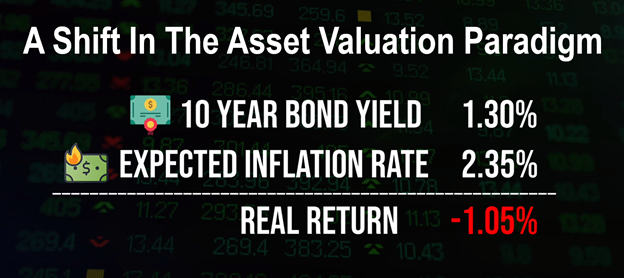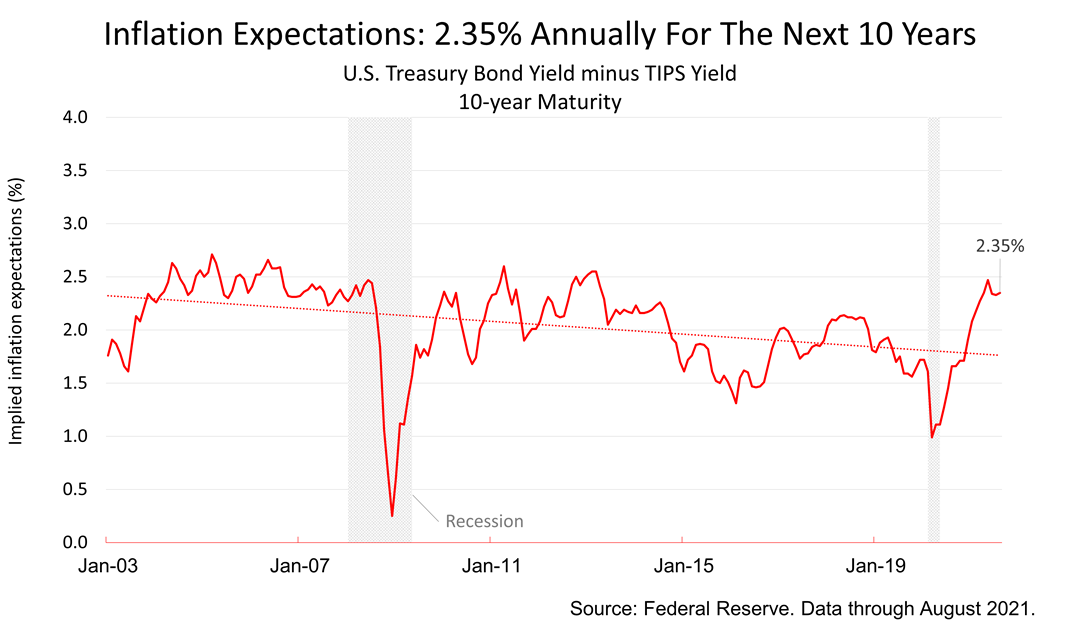Negative Real Returns On Bonds Changes The Asset Valuation Paradigm
Published Wednesday, September 22, 2021 at: 11:38 AM EDT
There’s a new paradigm in valuing stocks and bonds. The change in the relative value of stocks versus bonds – the two primary investments in a diversified portfolio -- has major implications for strategic retirement investors. Here’s what’s happening.
The bond market expects inflation for the next decade to annually average 2.35%, according to a market-based measure of expected inflation known as the Breakeven Inflation Rate. The BIR is derived from subtracting the current yield on 10-Year Treasury Inflation Protected Securities from the current yield on a 10-year Treasury bond.

With 10-year Treasury bonds currently yielding about 1.30%, and the breakeven inflation rate at 2.35%, the real return on a 10-year Treasury Bond is -1.5%! A negative expected return on a 10-year Treasury bond is unprecedented in modern history! It’s also unlikely to change anytime soon.
What’s it mean to you? It means that, even though stocks prices have been hitting new highs for many months, and even though stocks are trading at high price-to-earnings multiples compared to history, stocks are much more attractive than bonds. The rules of asset allocation don’t generally change much over the years, but a negative real return on long-term bonds is a major change to the asset valuation paradigm in place for decades. It’s wise for investors to adjust their long-term portfolio for the new asset valuation paradigm.
Nothing contained herein is to be considered a solicitation, research material, an investment recommendation, or advice of any kind, and it is subject to change without notice. Any investments or strategies referenced herein do not take into account the investment objectives, financial situation or particular needs of any specific person. Product suitability must be independently determined for each individual investor. Tax advice always depends on your particular personal situation and preferences. You should consult the appropriate financial professional regarding your specific circumstances. The material represents an assessment of financial, economic and tax law at a specific point in time and is not intended to be a forecast of future events or a guarantee of future results. Forward-looking statements are subject to certain risks and uncertainties. Actual results, performance, or achievements may differ materially from those expressed or implied. Information is based on data gathered from what we believe are reliable sources. It is not guaranteed as to accuracy, does not purport to be complete, and is not intended to be used as a primary basis for investment decisions. This article was written by a professional financial journalist for Advisor Products and is not intended as legal or investment advice.
This article was written by a professional financial journalist for Preferred NY Financial Group,LLC and is not intended as legal or investment advice.
An individual retirement account (IRA) allows individuals to direct pretax incom, up to specific annual limits, toward retirements that can grow tax-deferred (no capital gains or dividend income is taxed). Individual taxpayers are allowed to contribute 100% of compensation up to a specified maximum dollar amount to their Tranditional IRA. Contributions to the Tranditional IRA may be tax-deductible depending on the taxpayer's income, tax-filling status and other factors. Taxed must be paid upon withdrawal of any deducted contributions plus earnings and on the earnings from your non-deducted contributions. Prior to age 59%, distributions may be taken for certain reasons without incurring a 10 percent penalty on earnings. None of the information in this document should be considered tax or legal advice. Please consult with your legal or tax advisor for more information concerning your individual situation.
Contributions to a Roth IRA are not tax deductible and these is no mandatory distribution age. All earnings and principal are tax free if rules and regulations are followed. Eligibility for a Roth account depends on income. Principal contributions can be withdrawn any time without penalty (subject to some minimal conditions).
©2021 Advisor Products Inc. All Rights Reserved.

